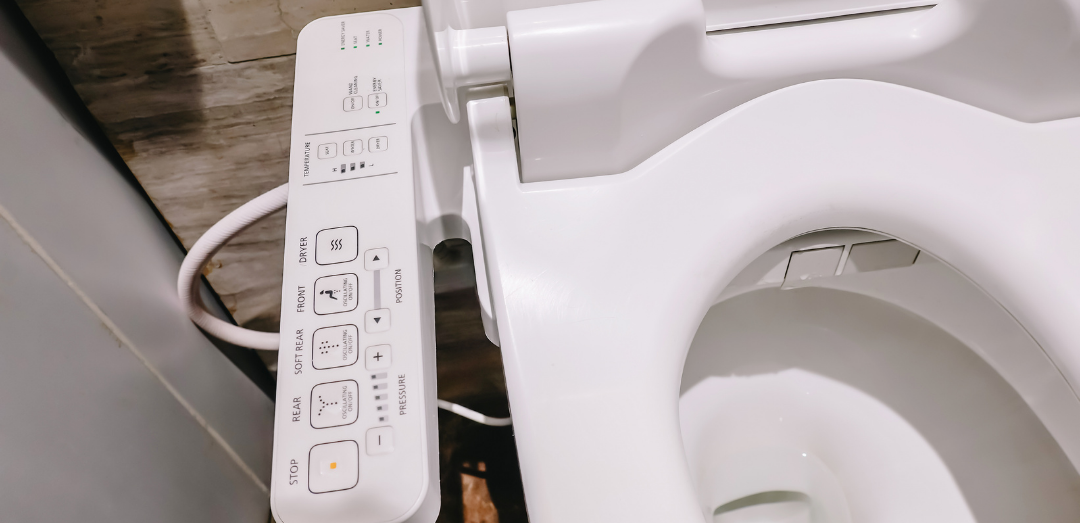
I have two girlfriends who are knowledgeable about home remodeling. I asked them for a bidet recommendation. This led to a discussion on toilet paper. We talked about the strengths and differences between bidets and toilet paper. Eventually, they asked, “which is more earth-friendly?”
The answer may surprise you: a bidet.
What is a bidet?
Bidets physically resemble a toilet but are designed to clean your bottom regions after using the toilet. In the U.S., A bidet can attach to the toilet, and a stream of water is directed toward you to clean. You can see the bidet attached to the toilet in the cover photo above. Some bidet fixtures are even built directly into the toilet. In Europe, toilets, and bidets are separate fixtures entirely.
There are add-ons such as a seat warmer and a blow-dry function so that no toilet paper is needed for wiping and drying. And best yet, a bidet uses 1/8th of a gallon of water (0.125 gallons or two cups) per flush versus 1.28 gallons (24.59 cups) per toilet flush.
The impact of toilet paper in the US
Everyone produces waste. So, naturally, we need a method to clean ourselves. People use toilet paper because they think there is no other option, and that is how they learn to clean themselves after using the bathroom. Bidets are the better alternative. And here are the numbers illustrating why:
- Over 36 billion rolls of toilet paper are produced annually
- That means around 15 million trees were destroyed and pulped
- Over 473 billion gallons of water are used every single year to flush and process toilet paper
- 253 thousand tons of chemicals are used to bleach the toilet paper
- 16.3 terawatts of electricity is used annually to manufacture the toilet paper we rely on
- A single roll of toilet paper requires 37 gallons of water, 1.3 kWh of electricity, and over a pound of wood pulp to produce and process.
In short, that is a lot of paper, water, and power used. It does not have to be this way.
We need to transition to bidets
Now you know how wasteful toilet paper is. Do bidets reduce or solve the impact toilet paper has on our environment? Take a look at these numbers and make that decision for yourself.
- A bidet uses just 1/8th of a gallon of water per use
- On average, daily bidet use decreases toilet paper consumption by 75%.
- If a human used a bidet as often as they used toilet paper, they’d save 384 trees throughout their lifetime. That adds up. Fast.
- All of that money saved not buying toilet paper can be spent on other essential goods, like reusable goods for your bathroom or kitchen.
Click here for more information on Bidets from the blog Treehugger.
Yes, we need something to clean ourselves after using the bathroom. But what we use does not need to be this wasteful. Bidets are a functional alternative that saves water, trees, and money. Better for the planet and better for your wallet, and it is a no-brainer.
That being said, I know upgrading a toilet isn’t easy. Price is always an important factor and can sometimes get in the way of changing habits and reducing your carbon footprint. This is why I put together three options you can choose from, so no matter what, you are doing good for yourself and for the planet. Once you choose an option, add it to your calendar. Assigning a date to a goal makes you much more likely to follow through.
- Green: make the switch to bamboo toilet paper or 20-60% post-consumer recycled content toilet paper
- Greener: upgrade to a low flush toilet
- Greenest: upgrade to a bidet
I highly recommend reading this report, The Issue With Tissue: How Americans Are Flushing Forests Down the Toilet Report by Natural Resources Defense Council or NRDC. This group was founded in 1970 with the mission “to ensure the rights of all people to clean air, clean water, and healthy communities.”
The executive summary describes a “tree-to-toilet pipeline.” Trees are grown over a long period, only to be destroyed for single-use consumption. This is profit-driven, plain, and simple. The toilet paper industry generates over 31 billion dollars of revenue every year. Worse yet, just 4% of the world’s population uses 20% of the global tissue supply.
We are in this together. Let’s go green.

